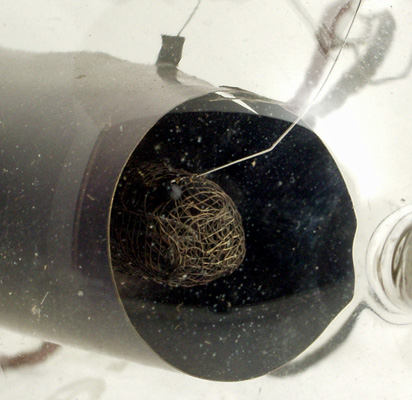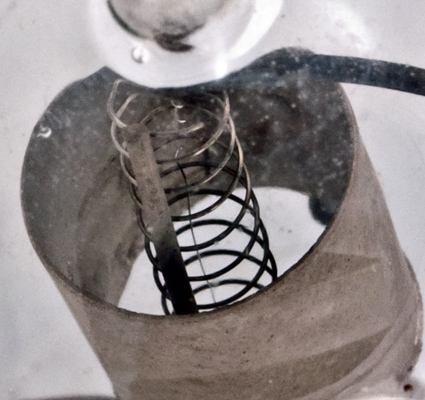|
Proceedings before the Court of Appeal
 
Left: The grid of Round soft valve N from 1913, Right: grid from Mullard ORA of 1922.
In the original case heard before Mr Justice Lawrence in July of 1922, the Marconis Wireless Telegraph Company, Ltd., sued the Mullard Radio Valve Company, Ltd., for damages for infringement of their rights in two patents, viz., (a)--No. 28413 of 1913 granted to Marconis Wireless Telegraph Company and Henry Joseph Round and (b) No. 126658 granted with the effective date of 1915 to Michel Peri and Jacques Biguet. The defendants counter-claimed that the patents in question were invalid for want of novelty and subject-matter.
It was held by the High Court that the Mullard valve was not an infringement of the Marconi patents, but that these were nevertheless good patents, and a certificate of their validity was granted.
An appeal was entered by the Marconi Company against this decision with a cross appeal on the question of validity by the Mullard Company. The case was heard before the Master of the Rolls and Lords Justices Younger and Warrington. The hearing extended over several days towards the end of last January and the beginning of February. Judgment was reserved and was finally issued on March 23rd.
Mr Hunter Gray, for the Marconi Company, laid most emphasis upon the Round patent, which, he claimed, was of far-reaching importance. Before the Round invention there was no record of the use of a cylindrical plate or grid in a three-electrode valve. The only known types of such, i.e., those of De Forest and Von Lieben, utilised a flat open- meshed member as a grid, and a similar shape for the plate anode.
The actual form of words used on the patent claim was as follows:- 'A vacuum tube containing a hot filament, a grid formed as a closed cylinder completely surrounding the filament, and a third electrode in the form of a cylinder surrounding the grid'.
Counsel asked the Court not to interpret the italicised words of the claim in their strictly literal sense. It was obviously impracticable to manufacture a grid with closed sides, because that would not allow the electrons to pass through to their goal (the plate), nor was it intended to shut in the ends of the grid so as to encase the filament as in a box.
What they were intended to convey was that the filament was completely surrounded by the grid in the 'electrical' sense. In other Words the grid constituted an 'electrical control' which was effective on all sides of the filament. An open spiral of wire served this purpose and fell within the scope of the patent. Counsel claimed that any three-electrode valve having a spiral grid and cylindrical plate infringed the patent rights of his clients.
In order to support this plea Mr Hunter Gray gave an interesting account of the defects of the early valves and of the problems which Captain Round solved by means of the invention now in question.
The modern 'hard' valve was unknown at the time when the Round patent was filed. The effect of the residual gas contained in the Audion or 'soft' type of valve was prejudicial to the steady working of the appliance. Further, the use of the older form of flat plate or anode was inefficient. In the first place collisions between the flying electrons and the free molecules of contained gas resulted in the production of positively-charged ions. In the second place the flat plate, being comparatively small in area, failed to collect all the electrons emitted from the filament. Many of these, in consequence, lodged upon the inner walls of the glass tube and set up a strong negative field in the interior of the vessel. Besides representing so much 'wasted energy' the negative charge so formed reacted upon the normal grid potential. A further complication followed from the presence of the positive ions previously alluded to. In order to overcome these sources of irregularity a constant readjustment of the grid potentiometer was found to be necessary.
By making his grid and plate cylindrical in form, Captain Round effectively shielded the inside surface of the tube from electrification, and so prevented the effect of that electrification on the grid potential. The cylindrical grid further controlled all the electrons in their passage towards the plate, and protected the filament from disintegration through the intermittent bombardment of positive ions.
The invention was of the first importance and Counsel appealed to the Court not to let the inventor be deprived of his rights by those who sought to obtain the same results by an arrangement which lay within the scope of the invention contained in Captain Rounds specification.
As regards the second patent (Peri and Biguet), this covered the well-known, 'French' valve in which all the electrodes were mounted in a common 'stub' at the base of the valve. The defendants had utilised the same essential features in making the Mullard valve.
Sir Duncan Kerley, for the Mullard Company, alleged that Captain Rounds invention was wholly directed to the solution of the particular problems met with in the case of 'soft' valves. The Mullard valve was 'hard'. There were no positive 'ions' to be dealt with, and the Round invention had no point of value in connection with it.
Moreover, Captain Round was limited to the form of words he chose to employ in his patent specification. He claimed a grid formed as a 'closed cylinder completely surrounding the grid' and he could not go outside them. His clients employed an open spiral of wire as a grid, and not a closed cylinder.
So far as the 'French' patent was concerned, it related only to a precise combination of well-known parts, and his client's construction differed from it in many respects. Their valve lay well outside the narrow scope covered by the Peri-Biguet specification.
In delivering judgment, the Master of the Rolls said that of the two Marconi patents concerned, that of Round was by far the more important. Peri and Biguets patent was limited to a particular construction of narrow scope which did not cover the Mullard valve.
As regards the Round specification the only point of difficulty lay in the precise construction to be placed upon the form of words used in describing the grid. The Court had come to the conclusion that the words of the claim intended to cover an arrangement in which the grid, at least, was made as a cylinder 'closed' in the ordinary physical or geometrical sense. The plaintiffs contention that the grid must be closed only in the 'electrical' sense could not be accepted. No doubt the arrangement described by Round was of great importance in the days when 'soft' valves were in general use, but it was of less value now that 'hard' valves were the rule. The appeal must therefore be dismissed.
It was held that the validity of the patents did not come into question, and the certificate given by the Court below accordingly holds good.
|